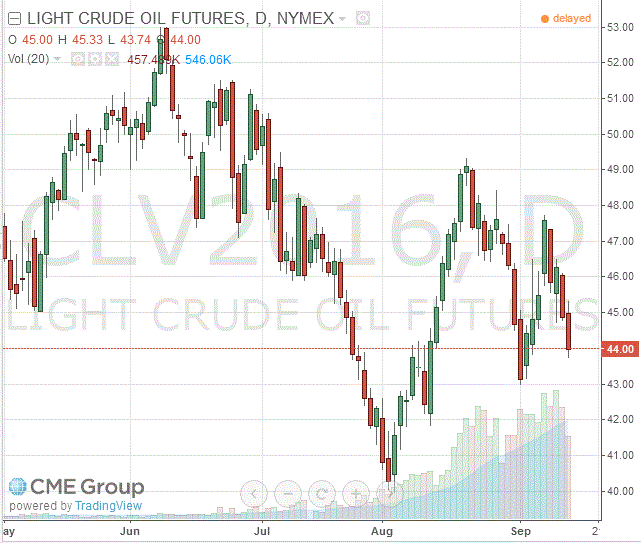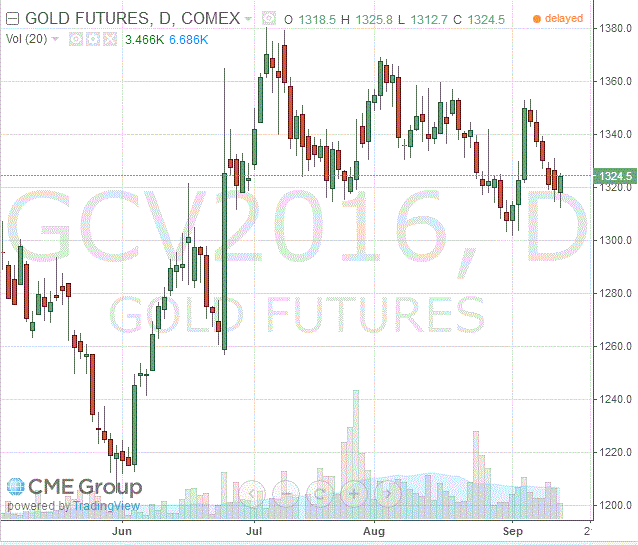Noticias del mercado
-
17:47
The price of oil has fallen about 2 percent
Oil futures fell, move caused by the publication of a controversial report on US petroleum inventories. At the same time, a further fall in prices restrained by the overall weakness of the US dollar.
US Department of Energy reported that in the week ended Sept. 9 oil inventories unexpectedly declined, but gasoline inventories rose slightly. According to the report, oil inventories fell by 559,000 barrels to 510.8 million barrels vs the average forecas of +4 million barrels. Oil reserves in the terminal Cushing (Oklahoma) fell by 1.2 million barrels to 62.2 million barrels. Gasoline stocks rose by 567,000 barrels to 228.4 million barrels. Analysts had expected an increase of 600,000 barrels. Distillate stocks rose 4.6 million barrels to 162.8 million barrels. Analysts had forecast an increase of 1.4 million barrels. The utilization of refining capacity decreased by 0.8% to 92.9%, while analysts expected a decline of 0.5%. Meanwhile, oil production in the US rose to 8.493 million barrels per day versus 8.458 million barrels per day in the previous week. US consumption of oil fell by 0.2 million barrels per day to 16.73 million barrels per day.
In general, data from the Ministry of Energy of the United States in contrast with yesterday's report from the American Petroleum Institute, which showed that the oil reserves in the country for the previous week rose 1.4 million barrels, which was much better than forecasts. Distillate stocks rose by 5.3 million barrels, while gasoline stocks fell by 2.4 million barrels.
In addition, traders continue to assess the likelihood that major oil producers will be able to agree to freeze production to support the market. OPEC members are expected to discuss a possible agreement on the limitation of oil production at an informal summit to be held in Algiers on 26-28 September. Earlier this year, an attempt to freeze the level of co-production failed due to the refuzal of Saudi Arabia to sign the agreement without the participation of Iran.
The cost of the October futures for US light crude oil WTI (Light Sweet Crude Oil) fell to 44.00 dollars per barrel on the New York Mercantile Exchange.
October futures price for North Sea petroleum mix of mark Brent fell to 46.22 dollars a barrel on the London Stock Exchange ICE Futures Europe.

-
17:24
Gold price show a modest increase
Gold prices rose moderately, aided by the widespread weakening of the US dollar, and reduced likelihood of a Fed hike at the next meeting.
The US Dollar Index, showing the US dollar against a basket of six major currencies, was down 0.23%. Since gold price is tied to the dollar, a weaker dollar makes the precious metal cheaper for holders of foreign currencies.
Mixed comments of members of the Fed's leadership, voiced recently, forced market participants doubt that the Central Bank will raise interest rates in September. This week Leil Brainard, a member of the Fed's Board of Governors, said that the grounds for preventive rate hikes seem less convincing.
"The focus of investors is still directed to the possible time of Fed hikes and dynamics of the market will be completely determined by this expectations", - Said David Gavett of Marex Spectron.
Traders believe that up to the Fed meeting, which will take place on 20-21 September, activity in the gold market will be restrained. "The market does not wait for a rate hike in September - said George Gero, expert at RBC Wealth Management." But as the prospects of rate hikes have not disappeared, gold rising moderately"
From a technical point of view, immediate resistance lies at $ 1330, while the range of $ 1,300- $ 1,310 is an important support.
The cost of the October futures for gold on COMEX rose to $ 1324.5 per ounce.

-
16:38
Huge drop for US crude oil inventories for the second week in a row
U.S. commercial crude oil inventories (excluding those in the Strategic Petroleum Reserve) decreased by 0.6 million barrels from the previous week. At 510.8 million barrels, U.S. crude oil inventories are at historically high levels for this time of year. Total motor gasoline inventories increased by 0.6 million barrels last week, and are well above the upper limit of the average range. Finished gasoline inventories decreased while blending components inventories increased last week. Distillate fuel inventories increased by 4.6 million barrels last week and are above the upper limit of the average range for this time of year. Propane/propylene inventories rose 2.0 million barrels last week and are above the upper limit of the average range. Total commercial petroleum inventories increased by 6.0 million barrels last week.
-
10:22
Oil is gaining in early trading
This morning, New York crude oil futures for WTI rose by 0.80% to $ 45.27 and Brent crude oil futures rose 0.53% to $ 47.34 per barrel. Thus, the black gold is trading in the green zone amid American Petroleum Institute's data that showed a slower increase in US oil inventories. According to API, the reserves of black gold in the country increased by 1.4 million barrels to 514.7 million over the week, while analysts had expected an increase of 3.8 million barrels. The official US government data on crude oil inventories will be published later today. Rising oil prices could hold back an increase in exports from Libya.
-
00:30
Commodities. Daily history for Sep 13’2016:
(raw materials / closing price /% change)
Oil 44.97+0.16%
Gold 1,322.10-0.12%
-